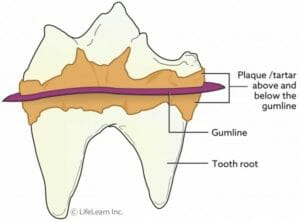Do you know the most common disease in dogs and cats? It is not liver or kidney disease, or even thyroid disease. It is dental disease! Did you know that dental disease affects over 80% of dogs over the age of 3 years, and between 50-90% of cats over 4 years? (Cornell University College of Veterinary Medicine). The issue with our pets is that they cannot tell us if they have a toothache! Even when they have severe dental disease, most pets do not show signs of discomfort. That is because they still are hungry and need to eat, and tend to hide their symptoms extremely well.
That is why regular veterinary exams are crucial to both treat and prevent dental disease. The veterinary care team can pick up problems before they even start. So what does a veterinary dental exam (included in every appointment) actually do?
First, we check all the teeth: are any missing? Are any broken? Are the gums normal or is there gingivitis (inflammation)? What Grade of dental disease is present (Grade 0 to 4)? Once this initial assessment is done, we will talk to you about next steps.
Can you spot the broken tooth in this photo?

Hint: top right!
Grade 0 dental disease: home care! Daily toothbrushing is so important in preventing disease. If brushing is impossible, prescription dental diets can hugely reduce tartar buildup. Our ultimate goal is to prevent disease rather than treating it when it is present!
Grade 1 dental disease: a professional dental cleaning with full mouth dental x-rays is required to assess the mouth, and clean/scale/polish teeth.
Grade 2-4 dental disease: a professional dental cleaning with full mouth dental x-rays is required, and likely teeth may need to be extracted based on the dental x rays. After Grade 2, pain is present, and the x rays will show us whether the teeth are still healthy, or are causing pain and need to be removed. The teeth will be cleaned, scaled and polished as well.

The only difference between us going to our dentist, and your pets coming to us, is that all professional dental procedures must be done under anesthesia—x rays are mandatory to check the teeth, as if they are not done, 50% of the problems will not be diagnosed. Prior to anesthesia, bloodwork will be done to ensure the process is as safe as possible. See the statement from the American Veterinary Dental College position statement Companion Animal Dental Scaling Without Anesthesia here: https://avdc.org/about/#pos-stmts
So, if you haven’t today, take a look at your pet’s mouth and if you have any concerns, give us a call to see how we can help you and your pet!
Dr. Amrita Banerjee